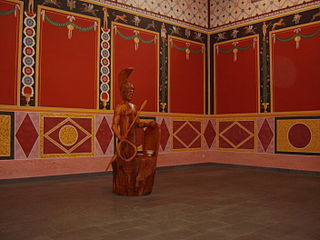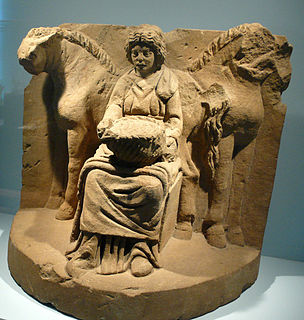
In Gallo-Roman religion, Cernunnos was a deity depicted with antlers, seated cross-legged, and is associated with stags, horned serpents, dogs, bulls, and rats. He is usually holding or wearing a torc and has been seen holding a bag of coins and a cornucopia. Believed to have originally been a Celtic deity, over 50 examples have been found from this time believed to be associated with him, concentrating in the north-eastern region of what was called Gaul by the ancient Romans. Cernunnos is also associated with the Wiccan Horned God in the modern religious tradition of Wicca.

Mercury is a major god in Roman religion and mythology, being one of the 12 Dii Consentes within the ancient Roman pantheon. He is the god of financial gain, commerce, eloquence, messages, communication, travelers, boundaries, luck, trickery, and thieves; he also serves as the guide of souls to the underworld.

Abellio was a god worshiped in the Garonne Valley in Gallia Aquitania, known primarily by a number of inscriptions which were discovered in Comminges, in the Pyrenees. He may have been a god of apple trees or the sun.
Lleu Llaw Gyffes is a hero of Welsh mythology. He appears most prominently in the Fourth Branch of the Mabinogi, the tale of Math fab Mathonwy, which tells the tale of his birth, his marriage, his death, his resurrection and his accession to the throne of Gwynedd. He is a warrior and magician, invariably associated with his uncle Gwydion.

In Gallo-Roman religion, Arvernus was the tribal god of the Arverni and an epithet of the Gaulish Mercury. Although the name refers to the Arverni, in whose territory Mercury had at important sanctuary at the Puy-de-Dôme in the Massif Central, all of the inscriptions to Mercury Arvernus are found farther away along the Rhenish frontier. The similar name Mercury Arvernorix, ‘king of the Arverni’, is also recorded once. Compare also the title Mercury Dumiatis, found in the territory of the Arverni. The name, like the name of the Arverni and of Auvergne, appears to derive from a Proto-Celtic compound adjective *φara-werno-s ‘in front of alders’.
Borvo or Bormo was an ancient Celtic god of healing springs worshipped in Gauls and Gallaecia. He was sometimes identified with the Graeco-Roman god Apollo, although his cult have preserved a high degree of autonomy during the Roman period.

Esus, Hesus, or Aisus was a Gaulish god known from two monumental statues and a line in Lucan's Bellum civile.

Grannus was a Celtic deity of classical antiquity. Based on the etymology of his name, Grannus may have been associated with spas, thermal springs, and the sun; having bushy hair, beard and/or eyebrows; or having a connection with the concept of shining/gleaming. He was regularly identified with Apollo as Apollo Grannus. He was frequently worshipped in conjunction with Sirona, and sometimes with Mars and other deities.

In Gallo-Roman religion, Loucetios was a Gallic god known from the Rhine-Moselle region, where he was identified with the Roman Mars. Scholars have interpreted his name to mean ‘lightning’. Mars Loucetius was worshipped alongside the goddess Nemetona.

Lugus was a deity of the Celtic pantheon. His name is rarely directly attested in inscriptions, but his importance can be inferred from place names and ethnonyms, and his nature and attributes are deduced from the distinctive iconography of Gallo-Roman inscriptions to Mercury, who is widely believed to have been identified with Lugus, and from the quasi-mythological narratives involving his later cognates, Welsh Lleu Llaw Gyffes and Irish Lugh Lámhfhada.

*Nodens or *Nodons is a Celtic healing god worshipped in Ancient Britain. Although no physical depiction of him has survived, votive plaques found in a shrine at Lydney Park (Gloucester) indicate his connection with dogs, a beast associated with healing symbolism in antiquity. The deity is known in only one other location, in Cockersand Moss (Lancashire). He was equated on most inscriptions with the Roman god Mars and likened to Silvanus. His name is cognate with that of later Celtic mythological figures, such as the Irish Nuada and the Welsh Nudd.

In Celtic mythology, Taranis, is the god of thunder, who was worshipped primarily in Gaul, Hispania, Britain, and Ireland but also in the Rhineland and Danube regions, amongst others. Taranis, along with Esus and Toutatis as part of a sacred triad, was mentioned by the Roman poet Lucan in his epic poem Pharsalia as a Celtic deity to whom human sacrificial offerings were made. Taranis was associated, as was the Cyclops Brontes ("thunder") in Greek mythology, with the wheel.
Mogons or Moguns was a Celtic god worshiped in Roman Britain and Gaul. The main evidence is from altars dedicated to the god by Roman soldiers.

Cissonius was an ancient Gaulish/Celtic god. After Visucius, Cissonius was the most common name of the Gaulish/Celtic Mercury; around seventeen inscriptions dedicated to him extend from France and Southern Germany into Switzerland.

Visucius was a Gallo-Roman god, usually identified with Mercury. He was worshipped primarily in the east of Gaul, around Trier and on the Rhine; his name is recorded on about ten dedicatory inscriptions. One such inscription has also been found in Bordeaux. Visucius is, along with Gebrinius and Cissonius, among the most common indigenous epithets of the Gaulish Mercury.

Lenus was a Celtic healing god worshipped mainly in eastern Gaul, where he was almost always identified with the Roman god Mars. He was an important god of the Treveri tribe, who had large sanctuaries at medicinal springs at Trier and the Martberg by Pommern in what is now Germany. Two dedications to him are also known from southwestern Britain. Edith Wightman characterizes him as “one of the best examples of a Teutates, or god of the people, equated with Mars—protector of the tribe in battle, but also [...] bestower of health and general good fortune” (p. 211). His sanctuary ‘Am Irminenwingert’ at Trier had a large temple, baths, smaller shrines and a theatre; that on the Martberg also included a large variety of buildings, probably including rooms for health-seeking pilgrims to stay. Despite his associations with healing, Lenus Mars is depicted classically as a warrior with Corinthian helmet in a bronze statuette from the Martberg.
Cicolluis or Cicoluis is a god in Celtic mythology worshiped by the ancient Gaulish peoples and having a parallel in Ireland. The name is Gaulish and means “All-Breast” or “Great-Breasted” and is probably used to signify strength. In the Gallo-Roman religion, Cicolluis is thought to be a common epithet for Gaulish Mars. A Latin dedicatory inscription from Narbonne, France, bears the words MARTI CICOLLUI ET LITAVI ., “Mars Cicolluis” has dedications in Xanten, Germany, and Aignay-le-Duc and Mâlain of the Côte-d'Or, France. “Cicolluis” is named alone in an inscription at Chassey, Côte-d'Or, Franche-Comté, France, and a partial inscription from Ruffey-lès-Echirey, Côte-d'Or, France, may be dedicated to Cicolluis. In Windisch, Switzerland, he is known as “Cicollus,” and in Dijon, Côte-d'Or, France, he is known as “Mars Cicoluis.”

Toutatis or Teutates is a Celtic god who was worshipped in ancient Gaul and Britain. On the basis of his name's etymology, he has been widely interpreted to be a tribal protector.

The gods and goddesses of the pre-Christian Celtic peoples are known from a variety of sources, including ancient places of worship, statues, engravings, cult objects and place or personal names. The ancient Celts appear to have had a pantheon of deities comparable to others in Indo-European religion, each linked to aspects of life and the natural world. By a process of syncretism, after the Roman conquest of Celtic areas, these became associated with their Roman equivalents, and their worship continued until Christianization. Pre-Roman Celtic art produced few images of deities, and these are hard to identify, lacking inscriptions, but in the post-conquest period many more images were made, some with inscriptions naming the deity. Most of the specific information we have therefore comes from Latin writers and the archaeology of the post-conquest period. More tentatively, links can be made between ancient Celtic deities and figures in early medieval Irish and Welsh literature, although all these works were produced well after Christianization.

Celtic is the mythology of Celtic polytheism, the religion of the Iron Age Celts. Like other Iron Age Europeans, the early Celts had a polytheistic mythology and religious structure. For Celts in close contact with Ancient Rome, such as the Gauls and Celtiberians, their mythology did not survive the Roman Empire, their subsequent conversion to Christianity and the loss of their Celtic languages. It is mostly through contemporary Roman and Christian sources that their mythology is preserved. The Celts who maintained either political or linguistic identities left vestigial remnants of their ancestral mythologies that were put into written form during the Middle Ages.

















